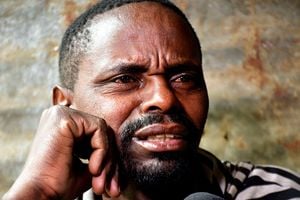What Kenya is ignoring in its latest CBC decision

Grade 3 pupils at Turi Sulgwita Primary School, Nakuru County, during a practical lesson.
President William Ruto’s declaration that Grade Seven to Grade Nine under the Competency-Based Curriculum will be hosted in primary schools marks a major policy reversal with far-reaching ramifications. It expands primary schooling from six to nine years, demolishes what was earlier conceived as three-year junior secondary schooling and shrinks secondary education to only three years of study: Grades 10, 11 and 12.
Effectively, this places Kenya among the few countries globally with the longest primary education cycle and shortest secondary education.
The declaration temporarily settles a contentious issue that has consumed the minds of parents, teachers and the general public because it affords the government and the education sector a chance to deal with the delicate question of transition from primary to secondary without the right structures.
However, it opens a new front for more intricate debates and raises critical questions which the Presidential Working Party on Education Reforms, the government, and education planners have to confront.
First is the conceptual and philosophical underpinnings of Grades Seven, Eight and Nine.
As currently conceived under the Basic Education Curriculum Framework developed by the Kenya Institute of Curriculum Development (KICD), Grades Seven to Nine are part of secondary education and designed to offer a broad-based curriculum to afford learners a chance to explore their own interests and potentials.
Three pathways
This level aims at laying the foundation for identifying talents and selection of career paths at senior secondary school.
Structurally, senior secondary has three pathways: Arts and Sports Science; Social Sciences; and Science, Technology, Engineering and Mathematics (Stem).
The tracks are further subdivided into nine tracks and the overall objective of this level is to promote specialisation and enable learners to pursue their interests and exploit their potential to the full.
The framework states that at junior secondary school, learners “undergo a rigorous career guidance programme and are exposed to the related learning areas to enable them make informed choices as they transit to senior school”.
Accordingly, Grades Seven to Nine offer 12 core subjects including English, Kiswahili or Kenyan Sign Language, mathematics, integrated science, health education and pre-technical and pre-career education.
In addition, there are optional subjects such as visual arts, performing arts, home science, computer science and foreign languages and indigenous languages that learners have to pick from.
Given this context, the question is: are primary schools prepared to offer the subjects?
From the outset, it is noted that the design of curriculum for the various subjects such as pre-technical and pre-career education cannot be introduced in primary schools.
Conversely, the Kenya Institute of Curriculum Development has to embark on urgent reviews and preferably scale them down in terms of depth and scope and create alignment across the entire education universe.
And this leads to the second point of debate, namely, teacher supply, competence, preparedness and deployment. Broadly, the education sector has suffered immensely due to an acute shortfall of teachers and which has been exacerbated with implementation of CBC that has peculiar requirements.
New learning areas
Statistics by the Teachers Service Commission (TSC) indicate that the country has a shortfall of more than 100,000 teachers, the bulk in secondary schools.
However, the government has committed to recruiting at least 30,000 by January — and the vacancies were announced on Friday — leaving a deficit of about 70,000. But this is part of the problem. CBC has new learning areas in Grades Seven to Nine like pre-technical and pre-career for which there are no teachers.
Related to this, the criteria for deploying teachers, known in education lingua as staffing norms, is being challenged.
At present, the staffing norms for secondary schools is based on curriculum establishment and stipulates that a teacher should teach two subjects and a minimum of 27 lessons a week.
For primary schools, the staffing norms is based on the number of streams.
Since the curriculum for Grades Seven to Nine is broad-based, the staffing norms has to change and will necessitate massive redeployment of teachers in the coming weeks.
Another issue is teacher training and skills upgrade for CBC implementation. The so-called retooling has been rushed, erratic and not properly thought-out to equip the teachers with the philosophical orientation and pedagogical approaches to implement the curriculum.
Third is financing, which has been acutely low for both primary and secondary schools. But it is worse at the primary level, where a learner is allocated Sh1,440 a year.
Even without CBC, this should have gone up and now with the placement of Grades Seven to Nine in primary, the figure should rise dramatically.
Already, the Kenya Primary Schools Heads Association (Kepsha) has proposed that the figure should increase to Sh7,500 a year, which is still modest given that Grades Seven to Nine will require workshops, laboratories and additional classrooms.
It is instructive that the previous Taskforce on Enhancing Access, Relevance, Transition, Equity and Quality for Effective Curriculum Reforms chaired by Prof Fatuma Chege did a mapping of secondary schools and established that there was a shortfall of 18,000 classrooms.
From its recommendations, the Jubilee administration embarked on construction of classrooms for junior secondary school. But this has stalled.
The Presidential Working Party chaired by Prof Raphael Munavu must carry out a similar exercise to determine the infrastructure requirements for Grades Seven to Nine.
Consequent to that, the government has to undertake massive construction of the facilities in readiness for the transition up to Grade Nine.
Fourth, an equally vexed question is keeping learners in primary till Grade Nine, which means staying there until age 15 or 16.
This goes against regional and global trends where primary schooling takes six or a maximum of seven years.
In East Africa, primary education takes seven years in Tanzania and Uganda and six in Rwanda.
Across the continent, most countries including South Africa, Nigeria and Ghana have six years of primary education.
In all, nine years of primary school is quite long and comes with socio-cultural and psychological implications.
Studies such as Conceptual Framework on School Readiness, published by Unicef in 2012, indicate that a long stay in primary school has psychological and sociological impacts on learners and affects completion and transition rates leading to high wastage in the system.
Age of rapid development
Statistics from the Kenya National Bureau of Statistics based on the current 8-4-4 system show that most learners drop out of school in Standard Seven and Eight because that is the age of rapid biological and psycho-social development that has an impact on completion and academic performance.
The Presidential Working Party has to advise whether the country will offer a nine-year primary school education or break it and transfer some years to the secondary cycle.
Significantly, attention must also focus on learners with special needs whose curriculum designs and modes of teaching have not been adequately addressed with the integration of Grades Seven to Nine in primary.
According to The Basic Education Statistical Booklet 2019, there were 3,043 special needs primary schools and 114 secondary schools with a combined enrolment of 140,875.
The KICD Curriculum Framework provides an elaborate programme for SNE but this has to be revised in view of the new developments.
Put together, the declaration on hosting Grades Seven to Nine in primary schools triggers a chain reaction and must be followed by clearly thought-out proposals to create a viable education system.
A system where learners take so long in primary school and a shorter period in secondary school and learning content and outcomes are not rationalised is outlandish in an age of technology and digital economy.
David Aduda, a Consulting Editor, is an education specialist. [email protected]





